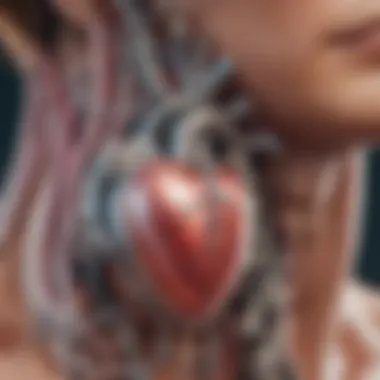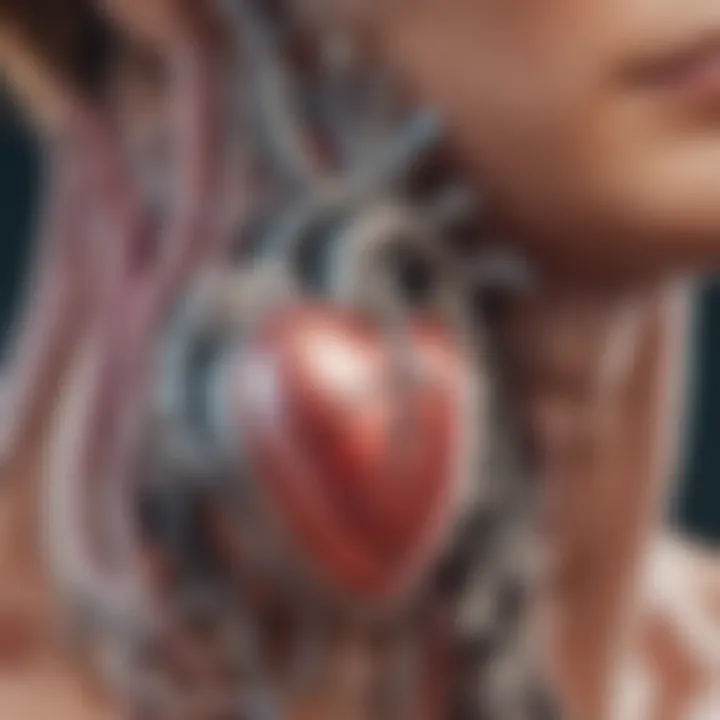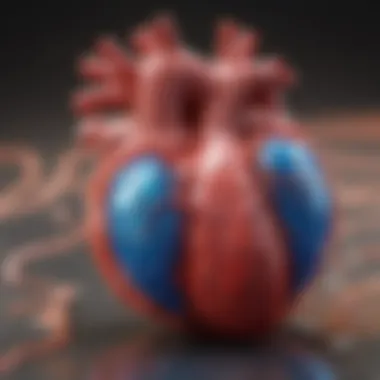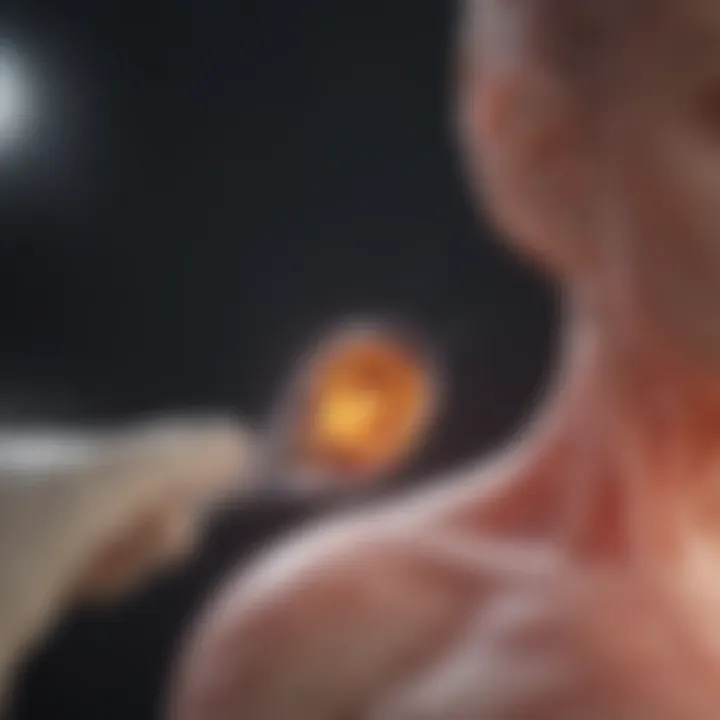Exploring Cardiovascular Implantable Electronic Devices


Research Overview
Cardiovascular implantable electronic devices (CIEDs) have altered the landscape of cardiac healthcare. The devices often include pacemakers and defibrillators. They are designed to regulate heart rhythms and enhance life quality for patients dealing with arrhythmias and other heart conditions. Such significance leads to ongoing studies exploring the effectiveness, safety, and advancements of CIEDs.
Summary of Key Findings
Research has shown that the use of CIEDs has significantly improved outcomes for many patients. For instance:
- Patients with implantable cardioverter-defibrillators (ICDs) have a 30% reduced risk of mortality when compared with those relying solely on medications.
- The integration of remote monitoring technologies has permitted quicker interventions, further improving patient prognoses.
- Studies indicate a high level of patient satisfaction and quality of life after receiving a CIED, making them an essential part of cardiac treatment.
Such findings are critical for future therapeutic strategies, especially in the context of aging populations that may be predisposed to cardiac disorders.
Importance of the Research
Understanding CIEDs is crucial given the rising prevalence of cardiovascular diseases worldwide. As the population ages, the demand for effective cardiac treatment solutions will only increase. Research in this area not only sheds light on the effectiveness of existing devices but also directs innovations that could enhance the devices’ functionality. This is pertinent for developing improved surgical techniques and addressing complications associated with CIEDs.
We can also nurture better health policies that prioritize comprehensive patient care, leading to enhancements in health systems globally.
Methodology
The exploration of CIEDs entails various methodologies that aid in grasping their impact on patient care.
Study Design
Most studies on CIEDs are longitudinal, focusing on patient outcomes over extended periods. These studies often compare group outcomes receiving CIEDs against those under traditional treatment modalities.
Data Collection Techniques
Information is gathered through clinical trials, patient registries, and retrospective analyses of patient records. These data collection techniques ensure a comprehensive view of the effectiveness and challenges associated with CIEDs. Common sources include:
- Clinical observations from cardiac practitioners
- Surveys capturing patient satisfaction and health outcomes
- Analysis of hospitalizations related to CIED complications
With these methodologies, researchers can establish a clearer understanding of how CIEDs impact not only immediate health outcomes but also long-term survivability and quality of life for patients.
Prelims to Cardiovascular Implantable Electronic Devices
Cardiovascular Implantable Electronic Devices (CIEDs) represent a significant advancement in modern medicine, primarily addressing various cardiac conditions that challenge effective heart function. These devices are essential tools in the management of arrhythmias, heart failure, and other critical heart-related health issues. The increasing prevalence of cardiovascular diseases worldwide highlights the importance of CIEDs in improving patient outcomes and enhancing life quality.
Definition and Importance
CIEDs encompass a range of instruments designed to monitor and regulate heart rhythms and functions. This group includes pacemakers, implantable cardioverter defibrillators (ICDs), and cardiac resynchronization therapy (CRT) devices. Each plays a unique role in heart health, with pacemakers primarily managing slow heartbeats, while ICDs deliver shocks to prevent life-threatening arrhythmias. CRT devices synchronize heart contractions, improving efficiency and function in patients with heart failure.
The relevance of CIEDs extends beyond mere function; they intimately tie into broader healthcare considerations. They provide valuable data about cardiac activity, allowing healthcare providers to make informed decisions. Moreover, these devices significantly decrease mortality rates associated with severe heart disorders.
Historical Development
The history of CIEDs dates back many decades, evolving from rudimentary designs to sophisticated electronic systems. The first cardiac pacemaker was invented in the late 1950s, marking a transformative era in cardiac care. Initially, these devices were large and required an external power source. However, technological advancements led to miniaturization, enhanced battery life, and increased functionality.
Over the years, improvements in device materials and biocompatibility allowed for safer surgeries and better integration with the human body. ICDs emerged in the 1980s, providing life-saving interventions for patients with lethal arrhythmias. The introduction of CRT devices in the early 2000s further changed the landscape, offering a new hope for heart failure patients.
As the field continues to advance, ongoing research aims to enhance the capabilities of CIEDs, including remote monitoring and leadless designs. This evolution illustrates a continuous commitment to improving patient care and outcomes in cardiovascular health.
Types of Cardiovascular Implantable Electronic Devices
Understanding the types of cardiovascular implantable electronic devices (CIEDs) is critical to grasping how they improve healthcare. CIEDs serve distinct but complementary roles in managing heart conditions. Each type has unique characteristics that cater to specific patient needs, enhancing quality of life and longevity. By recognizing their merits and challenges, we can better appreciate the advancements in cardiac therapies.
Pacemakers
Types of Pacemakers
Pacemakers are devices designed to regulate the heartbeat. The primary types include single-chamber, dual-chamber, and biventricular pacemakers. Single-chamber pacemakers use one lead to connect either to the right atrium or ventricle. Dual-chamber pacemakers utilize two leads to engage both the atrium and ventricle, allowing for more natural heart rhythm. Biventricular pacemakers stimulate both ventricles, which is essential for patients with heart failure. This diversity in designs caters to various cardiac conditions, making pacemakers a popular choice in CIED treatment plans. The ability to customize therapy contributes positively to patient outcomes, particularly in managing arrhythmias.
Indications for Use
The indications for using pacemakers revolve around electrical conduction issues of the heart. Conditions like bradycardia, or a slow heartbeat, necessitate this intervention to maintain adequate heart rates. Pacemakers are also indicated for specific types of heart block, where impulses are slowed down or blocked altogether. These indications are critical as they directly inform the clinical decision-making process, guiding healthcare professionals in optimizing patient management and ensuring the right device is chose for each unique case.
Benefits and Limitations
Pacemakers provide numerous benefits, such as improving the patient’s capacity to engage in everyday activities and enhancing overall quality of life. However, there are limitations as well. For instance, the need for battery replacements every several years and potential complications associated with the surgical implantation can be concerning. Additionally, some patients may experience discomfort or anxiety related to living with an implanted device. Weighing these benefits against limitations is critical in the patient selection process.
Implantable Cardioverter Defibrillators (ICDs)
Device Mechanism
Implantable cardioverter defibrillators are designed to monitor heart rhythms and correct life-threatening arrhythmias. They achieve this through a built-in algorithm that detects irregularities and automatically delivers electrical shocks or pacing. This life-saving mechanism underscores the significance of ICDs in contemporary cardiac care, particularly for patients at high risk of sudden cardiac arrest. The capability to respond instantly to arrhythmic events is one of the key features that makes them indispensable for certain individuals.
Clinical Applications


ICDs are primarily applied in patients with a history of ventricular fibrillation or significant ventricular tachycardia. Clinical guidelines recommend ICD placement for patients post-myocardial infarction when they exhibit reduced ejection fraction. The clinical applications are expansive, and they directly contribute to lowering mortality risk among high-risk populations. Furthermore, continuous research into refining device algorithms may lead to improved accuracy in rhythm detection and intervention, enhancing patient safety.
Risk Factors and Considerations
While ICDs offer significant benefits, there are risk factors and considerations that must be addressed. Patients may experience complications such as infections, lead displacement, and inappropriate shocks. Individual risk and living conditions are essential factors to consider before implantation. A thorough pre-operative assessment is crucial in addressing these concerns, ensuring that the benefits of ICD placement outweigh the potential risks.
Cardiac Resynchronization Therapy (CRT)
Indications for Patients
Cardiac resynchronization therapy is suitable for patients with heart failure who exhibit a specific type of ventricular conduction delay, known as left bundle branch block. CRT improves the efficiency of heart contractions, allowing for better blood flow and reduced symptoms of heart failure. Its targeted use addresses complex cardiac dynamics, ensuring that patients receive comprehensive care tailored to their specific needs.
Impact on Heart Function
The impact of CRT on heart function can be profound. By restoring synchronicity between the heart’s chambers, CRT enhances cardiac output and reduces symptoms associated with heart failure, such as fatigue and breathlessness. Studies indicate significant improvement in heart function and quality of life for many patients after CRT implementation. Understanding the physiological effects underscores the advancement of CRT as a valuable therapy in modern cardiology.
Challenges in Selection
Selecting appropriate candidates for CRT poses challenges. Patient response can vary significantly due to individual health profiles and comorbidities. Moreover, technical aspects of device programming and patient follow-up can complicate management. Identifying the right patient through rigorous assessment is fundamental in maximizing CRT's therapeutic benefits, ensuring that potential hurdles are addressed proactively.
Understanding the landscape of cardiovascular implantable devices is essential for advancing patient care and outcomes in the ever-evolving field of cardiology.
Physiology of CIED Functionality
Understanding the physiology underlying cardiovascular implantable electronic devices (CIEDs) is crucial for both medical professionals and patients. This section delves into the electrical activity of the heart and how CIEDs contribute to cardiac conduction. Such knowledge aids in comprehending how these devices enhance the functionality of the heart, particularly in patients with arrhythmias or heart block.
Electrical Activity of the Heart
The heart's electrical activity begins with the sinoatrial (SA) node, which generates electrical impulses. These impulses travel through the heart muscle, coordinating contractions and enabling efficient blood flow. Each heartbeat is carefully timed, ensuring that the heart pumps adequately with every contraction.
- SA Node Function: The SA node is often referred to as the heart's natural pacemaker because it initiates electrical impulses that dictate heart rhythm.
- Atrioventricular (AV) Node: This node further processes the electrical signals, allowing time for the atria to contract before the ventricles respond.
- Bundle of His and Purkinje Fibers: These structures distribute electrical impulses throughout the ventricles, promoting synchronous contractions.
When the heart’s natural pacemaking ability is compromised, CIEDs become essential. These devices deliver the necessary electrical impulses to maintain proper heart rhythm and function.
Role of CIEDs in Cardiac Conduction
Cardiovascular implantable electronic devices play a pivotal role in restoring normal rhythm and conduction when the physiological processes of the heart are disrupted. Their function can be summarized through several key points:
- Pacemakers: Designed to stimulate the heart when the electrical activity falls below optimal levels. They can deliver pacing signals when natural impulses are not sufficient.
- Implantable Cardioverter Defibrillators (ICDs): These devices monitor heart activity continuously. If they detect life-threatening arrhythmias, they provide an electrical shock to restore normal rhythm.
- Cardiac Resynchronization Therapy (CRT): This therapy coordinates the contractions of the heart's chambers by sending signals to specific areas, improving overall heart efficiency.
These devices also offer significant benefits, including the ability to respond to changing physiological conditions in real time. The integration of advanced technology allows for precise management of various cardiac conditions.
"The advancement in CIED technology represents a significant leap in cardiac healthcare, reflecting the intricate relationship between device functionality and cardiac physiology."
Implantation Procedures and Techniques
Understanding implantation procedures and techniques is crucial as they are the foundation for the success of cardiovascular implantable electronic devices (CIEDs). The effectiveness of devices such as pacemakers and defibrillators is directly linked to the precision of these surgical procedures. Proper techniques ensure optimal lead placement and minimize risks, leading to better patient outcomes.
Pre-Operative Assessments
Before any surgical intervention occurs, a thorough pre-operative evaluation is essential. This step entails assessing patient readiness, including a full clinical history, imaging, and other tests. It is imperative to confirm specific factors such as the patient’s cardiac anatomy and existing comorbidities.
Key elements of pre-operative assessments include:
- Echocardiography: Helps visualize heart structure and function.
- Electrophysiological Studies: Can clarify the type of arrhythmia present showing whether an electronic device is beneficial.
This thorough assessment aids in making informed decisions to prevent complications later in the process.
Surgical Techniques
The surgical techniques for implantation of CIEDs vary significantly based on the type of device and patient needs. The main methods include the transvenous approach and the subcutaneous approach.
Transvenous Approach
The transvenous approach is widely used for its direct access to the heart via the venous system. This technique involves inserting leads through a vein, typically the subclavian or femoral vein, into the heart's chambers.
A key characteristic of this approach is its reliability; it provides good lead stability and minimizes lead dislodgement. This makes it a popular choice among healthcare professionals.
A unique feature of the transvenous method is that it allows for multiple lead placements, which can enhance the function of devices like CRT systems. The advantages include a lower risk of infection due to internal placement, but it may also have disadvantages such as vascular complications or pneumothorax due to the invasive nature of the procedure.
Subcutaneous Approach
The subcutaneous approach is a newer technique that places the device under the skin. This is particularly useful in patients who need defibrillation capabilities without the risks associated with venous access.
The key characteristic here is that the procedure can be performed without entering the vascular system, which reduces certain complications, making it a beneficial choice for high-risk patients.
A unique feature of the subcutaneous approach is its external lead system; it decreases the likelihood of lead-related issues. However, disadvantages could include a possible increase in device size and cosmetic concerns for patients, particularly if the device is larger than its transvenous counterpart.
Considerations for Elderly Patients


When dealing with elderly patients, considerations must be tailored to their specific needs. Aging populations often present unique challenges, such as comorbidities or a more fragile physiological state.
The key characteristic when working with elderly patients is the need for careful pre-operative screening. This helps to evaluate risks effectively, making it a beneficial practice for ensuring patient safety.
A unique feature in this context is the approach to anesthesia and potential complications that may arise after surgery. Elderly patients often have longer recovery times, making post-operative care and monitoring quite crucial. Such considerations ensure that implantations are not only safe but also effective in improving outcomes.
Post-Operative Care
Post-operative care is equally important as it involves continuous monitoring and management of the patient's health status after the surgery. It includes assessing the implantation site for any signs of infection, ensuring device functionality, and addressing any immediate complications that may arise.
Successful post-operative management demands a structured plan, involving regular follow-ups and device checks, which ultimately enhances the quality of patient care.
Patient Management and Follow-Up
Effective patient management and follow-up are crucial elements in the lifecycle of cardiovascular implantable electronic devices (CIEDs). Once a device is implanted, ongoing monitoring and adjustments are necessary to ensure optimal performance and to support patient health. The importance of patient management cannot be overemphasized, as it directly affects device longevity and overall patient outcomes. By implementing regular follow-up procedures, healthcare professionals can identify potential complications early and address them promptly. This approach allows patients to maintain a better quality of life and reduces healthcare costs associated with unexpected emergencies.
Routine Monitoring
Routine monitoring is an essential practice following the implantation of a CIED. It includes regular follow-up appointments, device checks, and patient assessments. Typically, follow-ups occur at intervals defined by the specific device and the patient’s health status. These visits allow healthcare providers to evaluate device function, battery status, and efficacy in pacing or defibrillation. Additionally, they provide an opportunity for patients to report any symptoms or concerns that may arise.
As technology progresses, remote monitoring is also becoming prevalent, enabling continuous surveillance without necessitating frequent office visits. This method has shown to improve patient adherence and satisfaction, and data collected can be utilized for analyzing trends in a patient’s condition.
Device Interrogation
Device interrogation refers to the process of accessing and analyzing the data stored in the implanted device. This technique is integral to patient follow-up as it allows healthcare professionals to retrieve information on device performance, arrhythmia detection, and therapy delivery. Interrogation can help determine whether the device is functioning as intended and if any adjustments are needed.
Additionally, device interrogation allows for assessments regarding any abnormal behavior that could signal complications. Most modern CIEDs provide a wealth of data that can be accessed via specialized programming devices or through remote monitoring systems. This data-driven approach enhances decision-making, leading to better patient management strategies.
Managing Complications
Infection
Infection is a serious complication that can occur in patients with CIEDs. It generally results from the surgical process or skin bacteria entering the site. The presence of infection can endanger not only the device but also the patient’s life. It is critical for healthcare teams to be vigilant about signs of infection, which may include redness, swelling, or unusual discharge at the implantation site. Prompt recognition and management are essential to prevent further complications.
Infection is a common and well-recognized risk associated with CIED procedures. Identifying early signs of infection can minimize damage and help in devising effective treatment strategies, which may include antibiotic therapy or, in some cases, device removal.
Device Malfunction
Device malfunction is another concern that impacts the efficacy of CIEDs. Various factors, such as lead dislodgment, insulation failure, or battery depletion, can lead to malfunction. Frequent checks and device interrogation are critical in identifying any malfunction. Understanding the signs of malfunction can help facilititate timely intervention, allowing the healthcare team to consider adjustments or replacements as necessary. Regular follow-up is vital to detecting these issues early, which can lead to better outcomes for patients.
Patient Education
Patient education is essential for empowering individuals with CIEDs to manage their health effectively. Educated patients are more likely to recognize symptoms that indicate complications and seek assistance timely. Providing clear, comprehensive information regarding device function, device care, and potential risks forms a foundation for successful patient outcomes.
Involving patients in their care journey enhances compliance with follow-up appointments and routine monitoring. Engaging patients through educational materials—such as leaflets or workshops—ensures clarity regarding their responsibilities and lifestyle modifications required after device implantation. The educational effort reinforces the notion that empowered patients can play an active role in their healthcare, which ultimately leads to improved management of their CIED.
Technological Advancements in CIEDs
The importance of technological advancements in cardiovascular implantable electronic devices (CIEDs) cannot be overstated. As cardiovascular diseases become more prevalent, the need for effective diagnostic and therapeutic tools increases. Innovations in CIEDs enhance patient care, allowing for better management of heart conditions, improved patient outcomes, and the potential for reduced healthcare costs.
Advancements in technology bring about numerous benefits including miniaturization of devices, improved battery life, and increased functionality. These changes enable more patients to receive treatment and can lead to faster recovery times. Furthermore, advancements not only improve existing devices but also open up new avenues in research and development.
Leadless Pacemakers
Leadless pacemakers represent a significant evolution in cardiac pacing technology. Unlike traditional pacemakers which require leads that can sometimes cause complications, leadless devices eliminate them entirely. These small devices are implanted directly within the heart's right ventricle. The procedure for implantation is minimally invasive, resulting in less risk for the patient.
Benefits of leadless pacemakers include:
- Reduced risk of infections associated with leads.
- Smaller size, offering a cosmetic advantage.
- Longer battery life in some cases, leading to less frequent replacements.
However, challenges remain. The lack of leads means certain electrical connections are not available, which can limit device functionality in some patients. Despite these limitations, the overall trend towards leadless pacing offers exciting possibilities in the field of cardiac care.
Remote Monitoring Technologies
Remote monitoring technology has changed how healthcare professionals manage patients with CIEDs. This innovation enables healthcare providers to receive real-time data from devices, allowing for timely interventions when necessary. The integration of telehealth into CIED management allows for a continuous stream of information concerning a patient's heart health.
Some key points about remote monitoring include:
- Enhanced patient safety through constant monitoring.
- Early detection of potential complications before they become serious.
- Improved adherence to treatment regimens because patients feel supported.
Challenges still exist; data privacy and security must be addressed rigorously as sensitive patient information is shared online. Balancing patient autonomy with monitoring obligations is also crucial.
Biocompatible Materials
The use of biocompatible materials in CIEDs is essential to reducing the incidence of complications post-implantation. Quality materials can minimize the body’s inflammatory response to implanted devices. Recent advancements in material science have led to the development of various coatings and substances that improve device longevity and performance.
Advantages of biocompatible materials include:
- Decreased likelihood of rejection by the immune system.
- Improved integration with bodily tissue, ultimately leading to better outcomes for the patient.
- Extended lifespan of devices, reducing the frequency of replacements.


As the field moves forward, research continues to focus on creating materials that not only are compatible but enhance the functionality of CIEDs, allowing for more complex and effective treatment options.
Regulatory Perspectives
The regulatory environment surrounding cardiovascular implantable electronic devices (CIEDs) is critical for ensuring patient safety, device efficacy, and overall healthcare quality. Regulations act as a framework guiding the development, approval, and monitoring of CIEDs. Understanding these regulations is necessary for healthcare professionals, manufacturers, and patients alike, as they affect not only the market entry of devices but also their continued use post-implantation.
These regulatory perspectives encompass many aspects, including clinical trials, safety assessments, and ethical considerations. They aim to protect patients from harmful devices while enabling advancements in cardiac care technologies. Thorough regulation can minimize risks, enhance public trust, and set high standards across the medical field. It highlights the importance of both regulatory agencies and manufacturers in collaborating to keep improving patient care.
FDA Approval Process
The Food and Drug Administration (FDA) plays an essential role in the approval process of CIEDs in the United States. Before a device reaches the market, it must undergo rigorous evaluation to ensure its safety and effectiveness. The FDA employs several pathways for approval, including:
- Pre-market Notification (510(k)): This pathway allows manufacturers to demonstrate that their device is substantially equivalent to an already approved product.
- Pre-market Approval (PMA): This is a more intensive review process for new devices that are not similar to existing ones. The manufacturer must submit clinical data supporting the device's safety and effectiveness.
- Humanitarian Device Exemption (HDE): This is for devices intended to treat or diagnose conditions affecting fewer than 8,000 patients per year.
Once approved, the FDA continues to monitor the devices, which includes post-market surveillance to identify any long-term issues. Overall, the FDA’s thorough approach ensures devices provide real benefits without imposing unnecessary risks to patients.
International Standards
International standards in the realm of CIEDs promote safety and efficacy not just in the United States but around the world. Organizations like the International Organization for Standardization (ISO) and the International Electrotechnical Commission (IEC) establish guidelines that help harmonize device performance across countries.
These standards cover different aspects, such as:
- Quality Management Systems: Ensuring that manufacturers follow consistent practices in device design and production.
- Biocompatibility Testing: Assessing the material used in devices for any adverse reactions in the body.
- Electrical Safety: Standards related to the functioning of devices, minimizing risks like electrical shocks.
Adhering to international standards aids in building patient trust while facilitating the global exchange of medical devices. By understanding and following these standards, stakeholders in CIED technology can improve patient outcomes and enhance the overall healthcare landscape.
"Regulatory perspectives not only safeguard patients but also foster innovation in cardiac healthcare technology, driving improvements in treatment methods and patient outcomes."
Ethics and Patient Autonomy
Ethics and patient autonomy are pivotal components in the realm of healthcare, particularly when discussing cardiovascular implantable electronic devices (CIEDs). At the core of this topic is the recognition that patients must have the right to make informed decisions about their medical treatments. This is essential not only for building trust between patients and healthcare providers but also for ensuring that treatment aligns with the patients’ values and preferences.
The ethical principle of autonomy asserts that individuals should have the freedom to choose their paths when it comes to medical interventions. In the case of CIEDs, this becomes increasingly complex due to the technical nature of the devices and the potential risks involved in their implantation and subsequent management. Therefore, a comprehensive understanding of the procedures, benefits, and risks associated with CIEDs is necessary for true informed consent.
There are several elements to consider in the discussion of autonomy in relation to CIEDs:
- Informed consent is fundamental. Patients should receive clear, understandable information about CIED options, including how the devices work, the implications of undergoing a procedure, and the potential risks involved.
- Respect for patient choices is a moral obligation of healthcare providers. This means that practitioners must recognize and support the decisions patients make, even if those decisions diverge from medical recommendations.
- Continuous patient education stands as a requirement. As technologies develop, patients should be informed about new advancements, potential alternatives, and any changes to existing devices that may affect their choices.
The benefits of emphasizing ethics and patient autonomy include:
- Empowerment: When patients are informed and involved in decision-making, they tend to feel more in control of their health.
- Improved outcomes: Studies show that when patients are engaged in their care, adherence to treatment and satisfaction rates improve.
Informed Consent
Informed consent is a crucial aspect of patient autonomy and ethical medical practice, particularly regarding CIEDs. This process involves educating patients about the procedures, potential benefits, risks, and alternatives to implantation. The aim is to ensure that patients cannot only agree to a procedure, but understand it.
For informed consent to be valid, it must meet several criteria:
- Competence: Patients must be competent to understand the information provided to them.
- Disclosure: Healthcare providers must disclose all relevant information, including risks, benefits, and alternatives.
- Comprehension: Patients must accurately comprehend the information given to them in a way that relates to their individual circumstances.
- Voluntariness: Patients must make decisions free from coercion or undue influence.
Moreover, discussions should occur in a supportive environment where the patient feels comfortable asking questions. This dialogue fosters trust and encourages patients to express their concerns or preferences.
End-of-Life Considerations
End-of-life considerations are essential in the discussion concerning CIEDs, particularly as patients face advanced heart disease or terminal conditions. Decisions about whether to continue or withdraw therapies can profoundly affect the quality of life and dignity of patients.
Healthcare providers must adhere to several ethical principles:
- Respect for patient's wishes: Understanding a patient's goals for end-of-life care is crucial. Discussions should address whether a patient desires ongoing aggressive treatment or prefers a focus on comfort.
- Quality of life assessment: Evaluating the expected quality of life can help guide decisions on the appropriateness of devices like pacemakers or defibrillators in terminal phases of illness.
- Advance directives: Patients should be encouraged to express their preferences through advance care planning, ensuring that their wishes are respected.
Ultimately, managing the complexities of end-of-life considerations requires a thoughtful, patient-centric approach. This respects the autonomy and values of individuals, particularly in situations where advanced technologies like CIEDs intersect with sensitive healthcare decisions.
Future Directions in CIED Research
Research into cardiovascular implantable electronic devices (CIEDs) continues to evolve, guided by innovations and the search for enhanced patient outcomes. This exploration is vital as it not only shapes the next generation of devices but also directly impacts the quality of life for patients with heart conditions. Emphasis on research is crucial as it may lead to improved functionality, patient safety, and long-term management of cardiovascular diseases.
Emerging Technologies
Nano-Technology
Nano-technology significantly impacts the development of CIEDs. This field focuses on manipulating matter on an atomic and molecular scale, resulting in materials that can vastly improve the functionality of heart devices. One key characteristic of nano-technology is its ability to create smaller, more efficient devices that can be utilized with minimal invasiveness. A beneficial aspect of nano-technology is its potential for enhanced biocompatibility, reducing the likelihood of adverse reactions.
Unique features of nano-technology include its capacity for enabling drug delivery systems within the devices. This can help to provide localized treatment directly at the site of action, reducing systemic side effects. However, challenges remain, such as the complexity of scaling these processes for widespread use in CIEDs.
Smart CIEDs
Smart CIEDs are leading a revolution in heart care. These devices are equipped with connectivity features that allow them to communicate with external monitoring systems. The primary characteristic of smart CIEDs lies in their ability to transmit real-time data to healthcare providers, facilitating immediate feedback and adjustments as needed. This responsiveness is particularly popular as it can enhance day-to-day management for patients with chronic conditions.
A unique feature of smart CIEDs is their integration with mobile applications, enabling patients to monitor their own health metrics seamlessly. While the advantages here include empowerment of the patient and improved compliance, there are drawbacks like concerns regarding data privacy and the need for reliable internet connectivity.
Potential for Regenerative Medicine
The potential for regenerative medicine in the context of CIEDs offers promising avenues for the future. Research in this area is focused on how CIEDs might not just assist with the heart's rhythm but also contribute to the repair or regeneration of heart tissue itself. This shift could lead to devices that do more than just stabilize heart conditions; they may actively participate in healing the heart.
By leveraging biological mechanisms, we could advance treatments that nurture tissue regeneration. This intersection of technology and biology marks a significant development in heart care. However, it also necessitates rigorous testing to ensure safety and efficacy before integration into standard practice.



